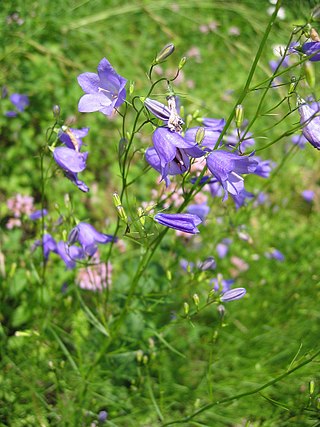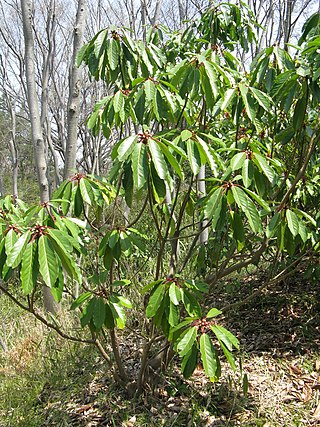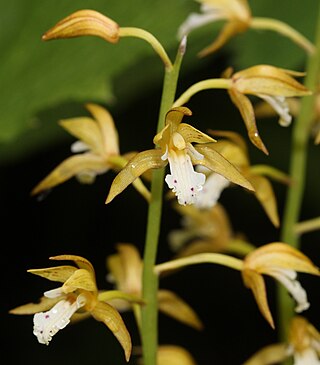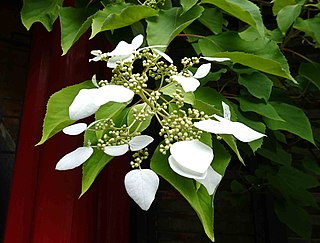
Amitostigma is a formerly recognized genus in the orchid family (Orchidaceae), now subsumed within Ponerorchis. It was an exclusively Asian genus of 28 orchids, growing in the alpine habitats of China, Taiwan, Japan, Korea, Vietnam, Thailand and the Kuril Islands. Twenty two species formerly placed in this genus grow in China.

Campanula rotundifolia, the harebell, Scottish bluebell, or bluebell of Scotland, is a species of flowering plant in the bellflower family Campanulaceae. This herbaceous perennial is found throughout the temperate regions of the northern hemisphere. In Scotland, it is often known simply as bluebell. It is the floral emblem of Sweden where it is known as small bluebell. It produces its violet-blue, bell-shaped flowers in late summer and autumn.

Symplocarpus is a genus of flowering plants in the family Araceae, native to United States, Canada and eastern Asia. The genus is characterized by having large leaves and deep root systems with contractile roots used for changing the plant's level with the ground. Symplocarpus species grow from a rhizome and their leaves release a foul odor when crushed.

Molinia, or moor grass, is a genus of two species of flowering plants in the grass family, native to damp moorland in Eurasia and northern Africa. They are both herbaceous perennial grasses.

Brachyelytrum is a genus of North American and East Asian plants in the grass family, classified in its own tribe Brachyelytreae.

Corallorhiza trifida, commonly known as early coralroot, northern coralroot, or yellow coralroot, is a coralroot orchid native to North America and Eurasia, with a circumboreal distribution. The species has been reported from the United States, Canada, Russia, China, Japan, Korea, India, Nepal, Kashmir, Pakistan, and almost every country in Europe.

Yucca gloriosa is a species of flowering plant in the family Asparagaceae, native to the southeastern United States. Growing to 2.5 m (8 ft), it is an evergreen shrub. It is widely cultivated as an ornamental for its architectural qualities, and has reportedly become established in warmer climates in the wild in various parts of the world.

Hypolytrum is a genus of plant in the family Cyperaceae. It contains approximately 60–70 species, native to tropical Africa, Asia, Australia, Latin America and various oceanic islands.

Aphyllorchis, commonly known as pauper orchids or as 無葉蘭屬/无叶兰属 , is a genus of about twenty species of terrestrial leafless orchids in the family Orchidaceae. Orchids in this genus have fleshy, upright stems and small to medium-sized resupinate flowers with narrow sepals and petals. They are native to a region extending from India east to China and Japan, south to Indonesia, New Guinea and Queensland.

The genus Arachnis, abbreviated as Arach in horticultural trade, is a member of the orchid family (Orchidaceae), consisting of more than 20 species native to China, India, Southeast Asia, Indonesia, the Philippines, New Guinea, and the Solomon Islands.

Lilium maculatum is a plant in the lily family native to Japan.

Flueggea, the bushweeds, is a genus of shrubs and trees in the family Phyllanthaceae first described as a genus in 1806. It is widespread across much of Asia, Africa, and various oceanic islands, with a few species in South America and on the Iberian Peninsula.

Daphniphyllum macropodum is a shrub or small tree found in China, Japan and Korea. Like all species in the genus Daphniphyllum, D. macropodum is dioecious, that is male and female flowers are borne on different plants. The timber is used in China in construction and furniture making. It is grown as an ornamental plant, chiefly for its foliage.

Epipactis papillosa is an orchid from the genus Epipactis. Epipactis papillosa is found from the Russia Far East, northeastern China (Liaoning), Korea and Japan. It grows 30–70 cm tall and has five to seven leaves. It blooms in the fall with 10-20 pale green flowers. It grows in forests.

Oreorchis patens, the common oreorchis or 山兰 , is a species of orchid native to eastern Asia. It is known from Japan, Korea, the Russian Far East, and China. The common oreorchis is a terrestrial orchid with a sympodial habit of growth; it flowers on an inflorescence bearing yellow blooms.

Allium thunbergii, Thunberg's chive or Thunberg garlic, is an East Asian species of wild onion native to Japan, Korea, and China. It grows at elevations up to 3000 m. The Flora of China recognizes A. tunbergii and A. stenodon as separate species, but more recent sources combine the two.

Clintonia udensis is a species of flowering plant in the lily family Liliaceae. It is the only species of Clintonia native to Asia. It prefers sparsely forested habitat including the alpine forests of the Himalayas.
Elaeocarpus stipularis is a tree in the Elaeocarpaceae family. It is found from the Aru Islands, eastern Indonesia, to Philippines, and through Mainland Southeast Asia to Odisha, India. It has edible fruit, its wood is used and some medical uses are ascribed to it.

Hydrangea hydrangeoides, the Japanese hydrangea vine, is a species of flowering plant in the family Hydrangeaceae, native to Ulleungdo Island of South Korea, Japan, and the southern Kuril Islands.

Magnolia compressa is a species of flowering plant in the family Magnoliaceae, native to Yunnan, Taiwan, the Ryukyu Islands, and southwest Japan, and introduced to South Korea. A small tree when in cultivation, it is hardy only to USDA zone 10. It may be planted in containers and brought indoors in the winter.



















